Evidence for Dark Energy Driven by Star Formation: Information Dark Energy?
Abstract
1. Introduction
2. Information Dark Energy (IDE)
3. Comparison of IDE Prediction with Experimental Measurements
4. Discussion
4.1. IDE Can Account for the Observed Dark Energy
4.2. Cause and Effect
4.3. IDE Should Resolve Some Problems and Tensions of ΛCDM
4.4. IDE Can Also Account for Dark-Matter Attributed Effects
5. Summary
Funding
Institutional Review Board Statement
Data Availability Statement
Acknowledgments
Conflicts of Interest
References
- Landauer, R. Irreversibility and Heat Generation in the Computing Process. IBM J. Res. Dev. 1961, 5, 183–191. [Google Scholar] [CrossRef]
- Landauer, R. Information is Physical. Phys. Today 1991, 44, 23–29. [Google Scholar] [CrossRef]
- Toyabe, S.; Sagawa, T.; Ueda, M.; Muneyuki, E.; Sano, M. Experimental demonstration of information-to-energy conversion and validation of the generalized Jarzynski equality. Nat. Phys. 2010, 6, 988–992. [Google Scholar] [CrossRef]
- Berut, A.; Arakelyan, A.; Petrosyan, A.; Ciliberto, A.; Dillenschneider, R.; Lutz, E. Experimental verification of Landauer’s principle linking information and thermodynamics. Nature 2012, 483, 187–189. [Google Scholar] [CrossRef]
- Jun, Y.; Gavrilov, M.; Bechhoefer, J. High-Precision Test of Landauer’s Principle in a Feedback Trap. Phys. Rev. Lett. 2014, 113, 190601. [Google Scholar] [CrossRef]
- Yan, L.L.; Xiong, T.P.; Rehan, K.; Zhou, F.; Liang, D.F.; Chen, L.; Zhang, J.Q.; Yang, W.L.; Ma, Z.H.; Feng, M. Single Atom Demonstration of the Quantum Landauer Principle. Phys. Rev. Lett. 2018, 120, 210601. [Google Scholar] [CrossRef]
- Wheeler, J.A.; Ford, K. Geons, Black Holes and Quantum Foam: A life in Physics; Norton: New York, NY, USA, 1998; ISBN 978-0393046427. [Google Scholar]
- Zeilinger, A. A Foundational Principle of Quantum Mechanics. Found. Phys. 1999, 29, 631–643. [Google Scholar] [CrossRef]
- Gough, M.P.; Carozzi, T.; Buckley, A.M. On the similarity of Information Energy to Dark Energy. Phys. Essays 2006, 19, 446–450. [Google Scholar] [CrossRef]
- Peebles, P.J.E. Principles of Physical Cosmology; Princeton University Press: Princeton NJ, USA, 1993; ISBN 978-0691209814. [Google Scholar]
- Gough, M.P. Information Equation of State. Entropy 2008, 10, 150–159. [Google Scholar] [CrossRef]
- Gough, M.P. Holographic Dark Information Energy. Entropy 2011, 13, 924–935. [Google Scholar] [CrossRef]
- Gough, M.P. Holographic Dark Information Energy: Predicted Dark Energy Measurement. Entropy 2013, 15, 1133–1149. [Google Scholar] [CrossRef]
- Gough, M.P. A Dynamic Dark Information Energy Consistent with Planck Data. Entropy 2014, 16, 1902–1916. [Google Scholar] [CrossRef]
- Gough, M.P. Information Dark Energy can Resolve the Hubble Tension and is Falsifiable by Experiment. Entropy 2022, 24, 385–399. [Google Scholar] [CrossRef] [PubMed]
- Frampton, P.H.; Hsu, S.D.H.; Kephart, T.W.; Reeb, D. What is the entropy of the universe? Class. Quantum Gravity 2009, 26, 145005. [Google Scholar] [CrossRef]
- Egan, C.A.; Lineweaver, C.H. A larger estimate of the entropy of the universe. Astrophys. J. 2010, 710, 1825–1834. [Google Scholar] [CrossRef]
- T’Hooft, G. Obstacles on the way towards the quantization of space, time and matter- and possible solutions. Stud. Hist. Philos. Sci. Part B Stud. Hist. Philos. Mod. Phys. 2001, 32, 157–180. [Google Scholar] [CrossRef]
- Susskind, L. The world as a hologram. J. Math. Phys. 1995, 36, 6377–6396. [Google Scholar] [CrossRef]
- Buosso, R. The holographic principle. Rev. Mod. Phys. 2002, 74, 825–874. [Google Scholar] [CrossRef]
- Chevallier, M.; Polarski, D. Accelerating universes with scaling dark matter. Int. J. Mod. Phys. D 2001, 10, 213–224. [Google Scholar] [CrossRef]
- Brout, D.; Scolnic, D.; Popovic, B.; Riess, A.G.; Carr, A.; Zuntz, J.; Kessler, R.; Davis, T.M.; Hinton, S.; Jones, D.; et al. The Pantheon+ Analysis: Cosmological Constraints. Astrophys. J. 2022, 938, 110. [Google Scholar] [CrossRef]
- DES Collaboration. The Dark Energy Survey: Cosmology Results with ~1500 new High-redshift Type 1a Supernovae using the full 5-year Dataset. Astrophys. J. Lett. 2024, 973, L14. [Google Scholar] [CrossRef]
- DESI Collaboration. DESI 2024 VI: Cosmological Constraints from the Measurements of Baryon Acoustic Oscillations. arXiv 2024. [CrossRef]
- Li, C.; White, S.D.M. The distribution of stellar mass in the low-redshift universe. Mon. Not. R. Astron. Soc. 2009, 398, 2177–2187. [Google Scholar] [CrossRef]
- Gallazzi, A.; Brinchmann, J.; Charlot, S.; White, S.D.M. A census of metals and baryons in stars in the local universe. Mon. Not. R. Astron. Soc. 2008, 383, 1439–1458. [Google Scholar] [CrossRef]
- Moustakas, J.; Coil, A.L.; Aird, J.; Blanton, M.R.; Cool, R.J.; Eisenstein, D.J.; Mendez, A.J.; Wong, K.C.; Zhu, G.; Arnouts, S. PRIMUS: Constraints on star formation quenching and Galaxy merging and the evolution of the stellar mass function from z = 0–1. Astrophys. J. 2013, 767, 50. [Google Scholar] [CrossRef]
- Bielby, R.; Hudelot, P.; McCracken, H.J.; Ilbert, O.; Daddi, E.; Le Fèvre, O.; Gonzalez-Perez, V.; Kneib, J.-P.; Marmo, C.; Mellier, Y.; et al. The WIRCam Deep Survey. I. Counts, colours, and mass functions derived from near-infrared imaging in the CFHTLS deep fields. Astron. Astrophys. 2012, 545, A23. [Google Scholar] [CrossRef]
- Pérez-González, P.G.; Rieke, G.H.; Villar, V.; Barro, G.; Blaylock, M.; Egami, E.; Gallego, J.; Gil de Paz, A.; Pascual, S.; Zamorano, J.; et al. The stellar mass assembly of galaxies from z = 0–4: Analysis of a sample selected in the rest-frame near infrared with Spitzer. Astrophys. J. 2008, 675, 234–261. [Google Scholar] [CrossRef]
- Ilbert, O.; McCracken, H.J.; Le Fèvre, O.; Capak, P.; Dunlop, J.; Karim, A.; Renzini, M.A.; Caputi, K.; Boissier, S.; Arnouts, S.; et al. Mass assembly in quiescent and star-forming Galaxies since z > 4 from UltraVISTA. Astron. Astrophys. 2013, 556, A55. [Google Scholar] [CrossRef]
- Muzzin, A.; Marchesini, D.; Stefanon, M.; Franx, M.; McCracken, H.J.; Milvang-Jensen, B.; Dunlop, J.S.; Fynbo, J.P.U.; Brammer, G.; Labbé, I.; et al. The evolution of the stellar mass functions of star-forming and quiescent galaxies to z = 4 from the COSMOS/UltraVISTA survey. Astrophys. J. 2013, 777, 18. [Google Scholar] [CrossRef]
- Arnouts, S.; Walcher, C.J.; Le Fèvre, O.; Zamorani, G.; Ilbert, O.; Le Brun, V.; Pozzetti, L.; Bardelli, S.; Tresse, L.; Zucca, E.; et al. The SWIRE-VVDS-CFHTLS surveys: Stellar Assembly over the last 10 Gyr. Astron. Astrophys. 2007, 476, 137–150. [Google Scholar] [CrossRef]
- Pozzetti, L.; Bolzonella, M.; Zucca, E.; Zamorani, G.; Lilly, S.; Renzini, A.; Moresco, M.; Mignoli, M.; Cassata, P.; Tasca, L.; et al. zCOSMOS—10k bright spectroscopic sample. The bimodality in the galaxy stellar mass function. Astron. Astrophys. 2010, 523, A13. [Google Scholar] [CrossRef]
- Kajisawa, M.; Ichikawa, T.; Tanaka, I.; Konishi, M.; Yamada, T.; Akiyama, M.; Suzuki, R.; Tokoku, C.; Uchimoto, Y.K.; Yoshikawa, T.; et al. MOIRCS deep survey IV evolution of galaxy stellar mass function back to z ~ 3. Astrophys. J. 2009, 702, 1393–1412. [Google Scholar] [CrossRef]
- Marchesini, D.; van Dokkum, P.G.; Forster Schreiber, N.M.; Franx, M.; Labbe, I.; Wuyts, S. The evolution of the stellar mass function of galaxies from z = 4 and the first comprehensive analysis of its uncertainties. Astrophys. J. 2009, 701, 1765–1769. [Google Scholar] [CrossRef]
- Reddy, N.; Dickinson, M.; Elbaz, D.; Morrison, G.; Giavalisco, M.; Ivison, R.; Papovich, C.; Scott, D.; Buat, V.; Burgarella, D.; et al. GOODS-HERSCHEL measurements of the dust attenuation of typical star forming galaxies at high redshift. Astrophys. J. 2012, 744, 154. [Google Scholar] [CrossRef]
- Caputi, K.J.; Cirasuolo, M.; Jdunlop, J.S.; McLure, R.J.; Farrah, D.; Almaini, O. The stellar mass function of the most massive Galaxies at 3 < z < 5 in the UKIDSS Ultra Deep Survey. Mon. Not. R. Astron. Soc. 2011, 413, 162–176. [Google Scholar] [CrossRef]
- Gonzalez, V.; Labbe, I.; Bouwens, R.J.; Illingworth, G.; Frank, M.; Kriek, M. Evolution of galaxy stellar mass functions, mass densities, and mass-to light ratios from z ∼ 7 to z ∼ 4. Astrophys. J. 2011, 735, L34. [Google Scholar] [CrossRef]
- Lee, K.-S.; Ferguson, H.C.; Wiklind, T.; Dahlen, T.; Dickinson, M.E.; Giavalisco, M.; Grogin, N.; Papovich, C.; Messias, H.; Guo, Y.; et al. How do star-forming galaxies at z > 3 assemble their masses? Astrophys. J. 2012, 752, 66. [Google Scholar] [CrossRef]
- Cole, S.; Norberg, P.; Baugh, C.M.; Frenk, C.S.; Bland-Hawthorn, J.; Bridges, T.; Cannon, R.; Colless, M.; Collins, C.; Couch, W.; et al. The 2dF galaxy redshift survey. Mon. Not. R. Astron. Soc. 2001, 326, 255–273. [Google Scholar] [CrossRef]
- Dickinson, M.; Papovich, C.; Ferguson, H.C.; Budavari, T. The evolution of the global stellar mass density a 0 < z < 3. Astrophys. J. 2003, 587, 25–40. [Google Scholar] [CrossRef]
- Rudnick, G.; Rix, H.; Franx, M.; Labbe, I.; Blanton, M.; Daddi, E.; Schreiber, N.M.F.; Moorwood, A.; Rottgering, H.; Trujillo, I.; et al. The rest-frame optical luminosity density, colour, and stellar mass density of the universe from z = 0 to z = 3. Astrophys. J. 2003, 599, 847–864. [Google Scholar] [CrossRef]
- Brinchmann, J.; Ellis, R.S. The ma.ss assembly and star formation characteristics of field galaxies of known morphology. Astrophys. J. 2000, 536, L77–L80. [Google Scholar] [CrossRef] [PubMed]
- Elsner, F.; Feulner, G.; Hopp, U. The impact of Spitzer infrared data on stellar mass estimates. Astron. Astrophys. 2008, 477, 503–512. [Google Scholar] [CrossRef]
- Drory, N.; Salvato, M.; Gabasch, A.; Bender, R.; Hopp, U.; Feuler, G.; Pannella, M. The stellar mass function of galxies to z ~ 5 in the FORS Deep and GOODS-South Fields. Astrophys. J. 2005, 619, L131–L134. [Google Scholar] [CrossRef]
- Drory, N.; Alvarez, M. The contribution of star formation and merging to stellar mass buildup in galaxies. Astrophys. J. 2008, 680, 41–53. [Google Scholar] [CrossRef]
- Fontana, A.; Donnarumma, I.; Vanzella, E.; Giallongo, E.; Menci, N.; Nonino, M.; Saracco, P.; Cristiani, S.; D’Odorico, S.; Poli, F. The assembly of massive galaxies from near Infrared observations of Hubble deep-field south. Astrophys. J. 2003, 594, L9–L12. [Google Scholar] [CrossRef][Green Version]
- Fontana, A.; Salimbeni, S.; Grazian, A.; Giallongo, E.; Pentericci, L.; Nonino, M.; Fontanot, F.; Menci, N.; Monaco, P.; Cristiani, S.; et al. The galaxy mass function up to z = 4 in the GOODS-MUSIC sample. Astron. Astrophys. 2006, 459, 745–757. [Google Scholar] [CrossRef]
- Cohen, J.G. CALTECH faint galaxy redshift survey. Astrophys. J. 2002, 567, 672–701. [Google Scholar] [CrossRef]
- Conselice, C.J.; Blackburne, J.A.; Papovich, C. The luminosity, stellar mass, and number density evolution of field galaxies. Astrophys. J. 2005, 620, 564–583. [Google Scholar] [CrossRef]
- Borch, A.; Meisenheimer, K.; Bell, E.F.; Rix, H.-W.; Wolf, C.; Dye, S.; Kleinheinrich, M.; Kovacs, Z.; Wisotzki, L. The stellar masses of 25000 galaxies at 0.2 <z <1.0 estimated by COMBO-17 survey. Astron. Astrophys. 2006, 453, 869–881. [Google Scholar] [CrossRef][Green Version]
- Madau, P.; Dickinson, M. Cosmic Star Formation History. Ann. Rev. Astron. Astrophys. 2014, 52, 415–486. [Google Scholar] [CrossRef]
- Friedmann, A. On the Curvature of Space. Gen. Relativ. Gravit. 1999, 31, 1991–2000. [Google Scholar] [CrossRef]
- Aghanim, N.; Akrami, Y.; Ashdown, M.; Aumont, J.; Baccigalupi, C.; Ballardini, M.; Banday, A.J.; Barreiro, R.B.; Bartolo, N.; Basak, S.; et al. Planck 2018 results. VI, Cosmological Parameters. Astron. Astrophys. 2020, 641, A6. [Google Scholar] [CrossRef]
- Voit, G.M. Tracing cosmic evolution with clusters of galaxies. Rev. Mod. Phys. 2005, 77, 207–258. [Google Scholar] [CrossRef]
- Basu, B.; Lynden-Bell, D. A survey of entropy in the universe. Q. Jl. R. Astr. Soc. 1990, 31, 359–369. [Google Scholar]
- Babyk, I.V.; McNamara, B.R. The Halo Mass-Temperature Relation for Clusters, Groups, and Galaxies. Astrophys. J. 2023, 946, 54. [Google Scholar] [CrossRef]
- Guzzo, L.; Pierleoni, M.; Meneux, B.; Branchini, E.; LeFevre, O.; Marinoni, C.; Garilli, B.; Blaizot, J.; DeLucia, G.; Pollo, A.; et al. A test of the nature of cosmic acceleration using galaxy redshift distortions. Nature 2008, 451, 541. [Google Scholar] [CrossRef]
- Frieman, J.A.; Turner, M.S.; Huterer, D. Dark energy and the accelerating universe. Ann. Rev. Astron. Astrophys. 2008, 46, 385. [Google Scholar] [CrossRef]
- Weinberg, S. The cosmological constant problem. Rev. Mod. Phys. 1989, 61, 1–23. [Google Scholar] [CrossRef]
- Benevento, G.; Hu, W.; Raven, M. Can late dark energy raise the Hubble constant? Phys. Rev. D 2020, 101, 103517. [Google Scholar] [CrossRef]
- Keeley, R.; Joudaki, S.; Kaplinghat, M.; Kirkby, D. Implications of a transition in the dark energy equation of state for the H0 and σ8 tensions. J. Cosmol. Astropart. Phys. 2019, 12, 035. [Google Scholar] [CrossRef]
- Peracaula, J.S.; Gomez-Valent, A.; De Cruz Perez, J.; Moreno-Pulido, C. Running vacuum against the H0 and σ8 tensions. Explor. Front. Phys. 2021, 134, 19001. [Google Scholar] [CrossRef]
- Akarsu, O.; De Felice, A.; Di Valentino, E.; Kumar, S.; Nunes, R.C.; Özülker, E.; Vazquez, J.A.; Yadav, A. Cosmological constraints on Λ8CDM scenario in a typeII minimally modified gravity. Phys. Rev. D 2024, 110, 103527. [Google Scholar] [CrossRef]
- Sorini, D.; Peacock, J.A.; Lombriser, L. The impact of the cosmological constant on past and future star formation. Mon. Not. R. Astron. Soc. 2024, 535, 1449–1474. [Google Scholar] [CrossRef]
- Aalbers, J.; Akerib, D.S.; Al Musalhi, A.K.; Alder, F.; Amarasinghe, C.S.; Ames, A.; Anderson, T.J.; Angelides, N.; Araújo, H.M.; Armstrong, J.E.; et al. First constraints on WIMP-nucleon effective field theory couplings in an extended energy region from LUX-ZEPLIN. Phys. Rev. D 2024, 109, 092003. [Google Scholar] [CrossRef]
- McGaugh, S.S.; Lelli, F.; Schombert, J.M. The Radial Acceleration Relation in Rotationally Supported Galaxies. Phys. Rev. Lett. 2016, 117, 201101. [Google Scholar] [CrossRef]
- Lelli, F.; McGaugh, S.S.; Schombert, J.M.; Pawlowski, M.S. One Law to Rule them all: The Radial Acceleration relation of Galaxies. Astrophys. J. 2017, 836, 152. [Google Scholar] [CrossRef]
- Viola, M.; Cacciato, M.; Brouwer, M.; Kuijken, K.; Hoekstra, H.; Norberg, P.; Robotham, A.S.G.; van Uitert, E.; Alpaslan, M.; Baldry, I.K.; et al. Dark matter halo properties of GAMA galaxy groups from 100 square degrees of KiDS weak lensing data. Mon. Not. R. Astron. Soc. 2015, 452, 3529–3550. [Google Scholar] [CrossRef]
- Markevich, M.; Gonzalez, A.H.; Clowe, D.; Vikhlinin, A.; Forman, W.; Jones, C.; Murray, S.; Tucker, W. Direct constraints on the dark matter self-interaction cross-section from the merging galaxy cluster. Astrophys. J. 2004, 606, 819–824. [Google Scholar] [CrossRef]
- Harvey, D.; Massey, R.; Kitching, T.; Taylor, A.; Tittley, E. The non gravitational interactions of dark matter in colliding galaxy clusters. Science 2015, 347, 1462–1465. [Google Scholar] [CrossRef]
- Massey, R.; Williams, L.; Smit, R.; Swinbank, M.; Kitching, T.D.; Harvey, D.; Jauzac, M.; Israel, H.; Clowe, D.; Edge, A.; et al. The behaviour of dark matter associated with four bright Cluster galaxies in the 10 kpc core of Abell 3827. Mon. Not. R. Astron. Soc. 2015, 449, 3393–3406. [Google Scholar] [CrossRef]
- McGaugh, S.S.; Schombert, J.M.; Lelli, F.; Franck, J. Accelerated Structure Formation: The Early Emergence of Massive Galaxies and Clusters of Galaxies. Astrophys. J. 2024, 976, 13. [Google Scholar] [CrossRef]
- Sobral, D.; Small, I.; Best, P.N.; Geach, J.E.; Yuichi, M.; Stott, J.P.; Cirasuolo, M.; Jaron, K. A large Hα survey at z = 2.23, 1.47, 0.84 and 0.40: The 11 Gyr evolution of star-forming galaxies from HiZELS. Mon. Not. R. Astron. Soc. 2013, 428, 1128. Available online: https://academic.oup.com/mnras/article/428/2/1128/1000290 (accessed on 15 November 2024). [CrossRef]
- Cortes, M.; Liddle, A.R. Interpretting DESI’s evidence for evolving dark energy. J. Cosmol. Astropart. Phys. 2024, 12, 007. [Google Scholar] [CrossRef]
- Migkas, K. Probing cosmic isotropy with a new X-ray galaxy cluster sample through the Lx-T scaling relation. Astron. Astrophys. 2020, 636, A15. [Google Scholar] [CrossRef]
- Vagnozzi, S. Seven Hints that Early-Time new physics alone is not sufficient to solve the Hubble tension. Universe 2023, 9, 393. [Google Scholar] [CrossRef]

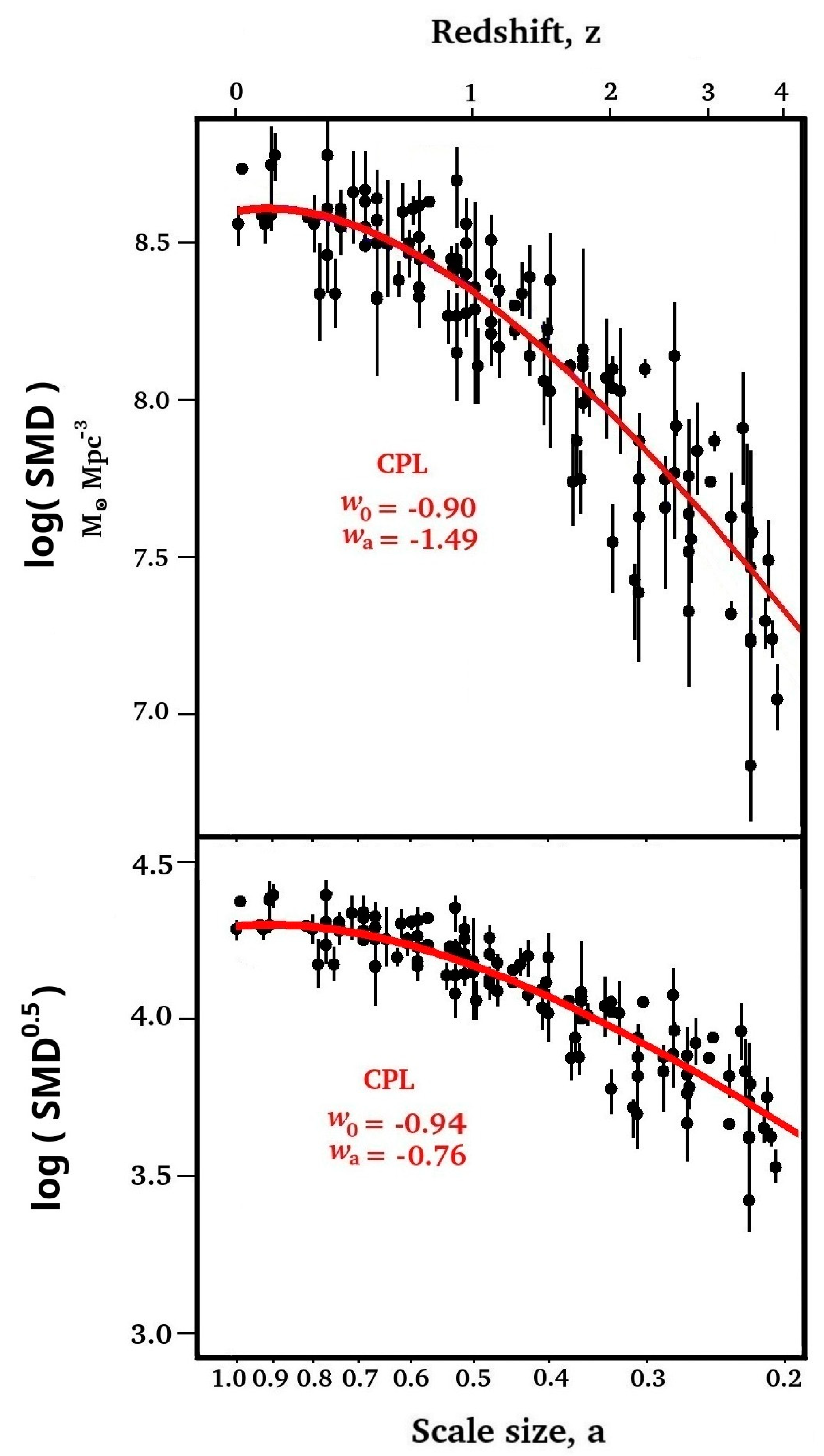
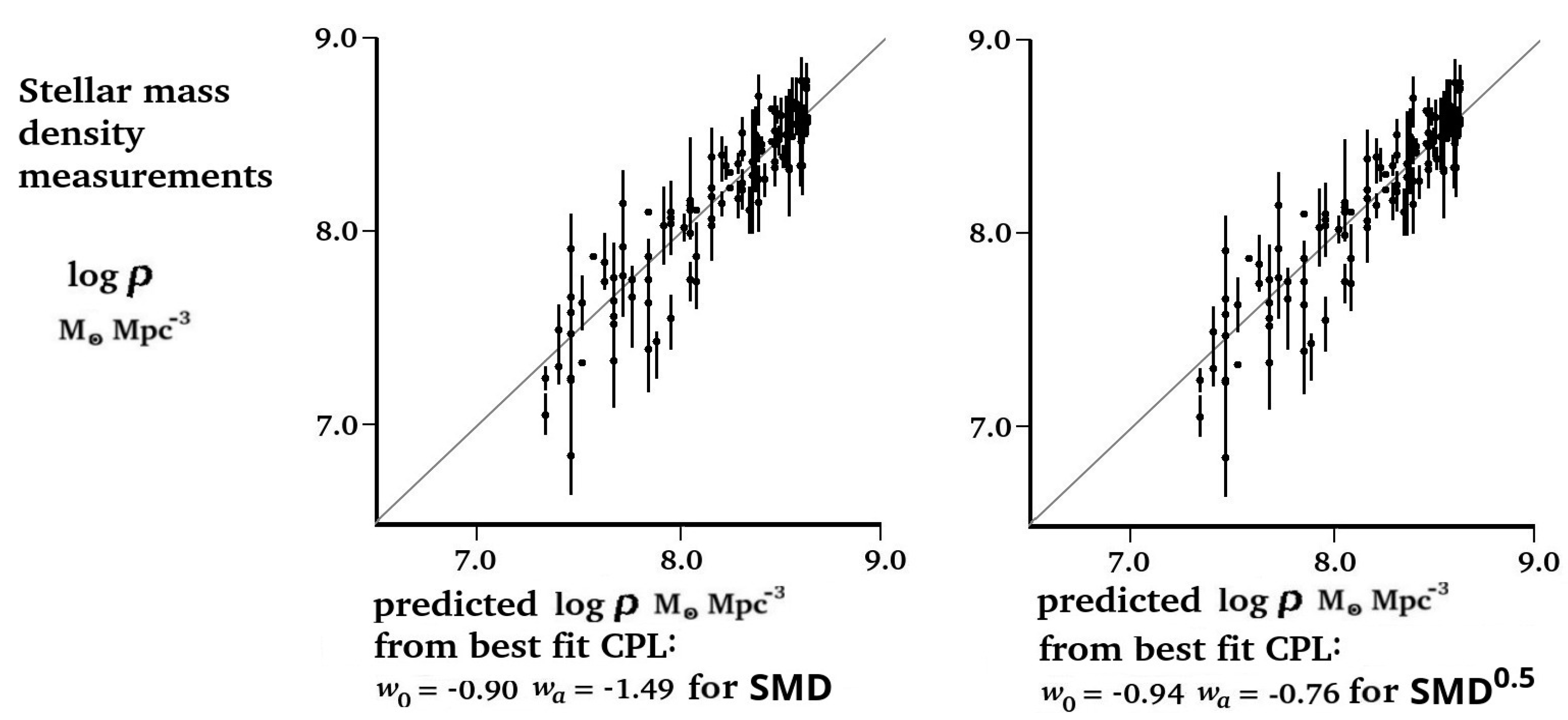

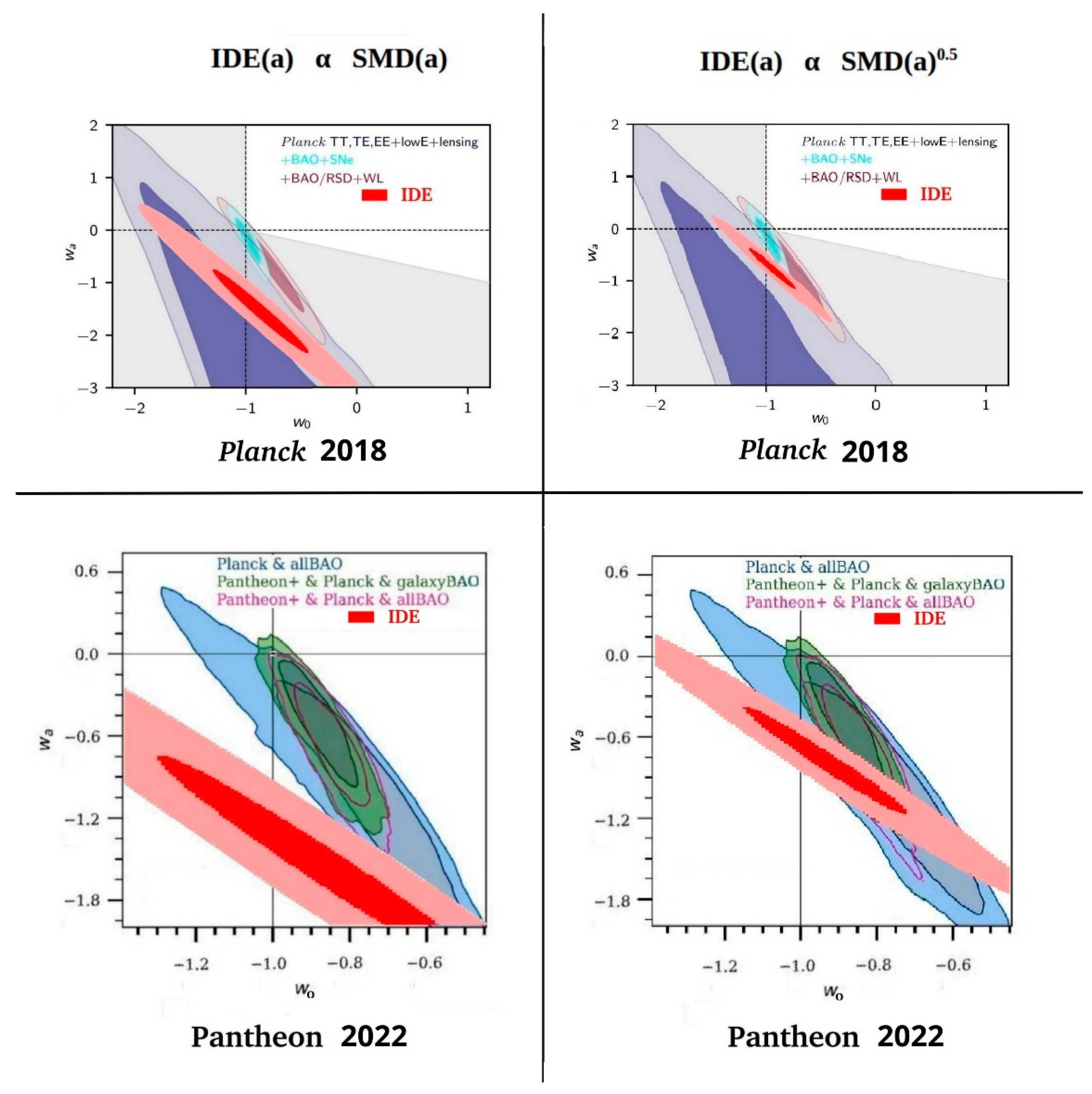
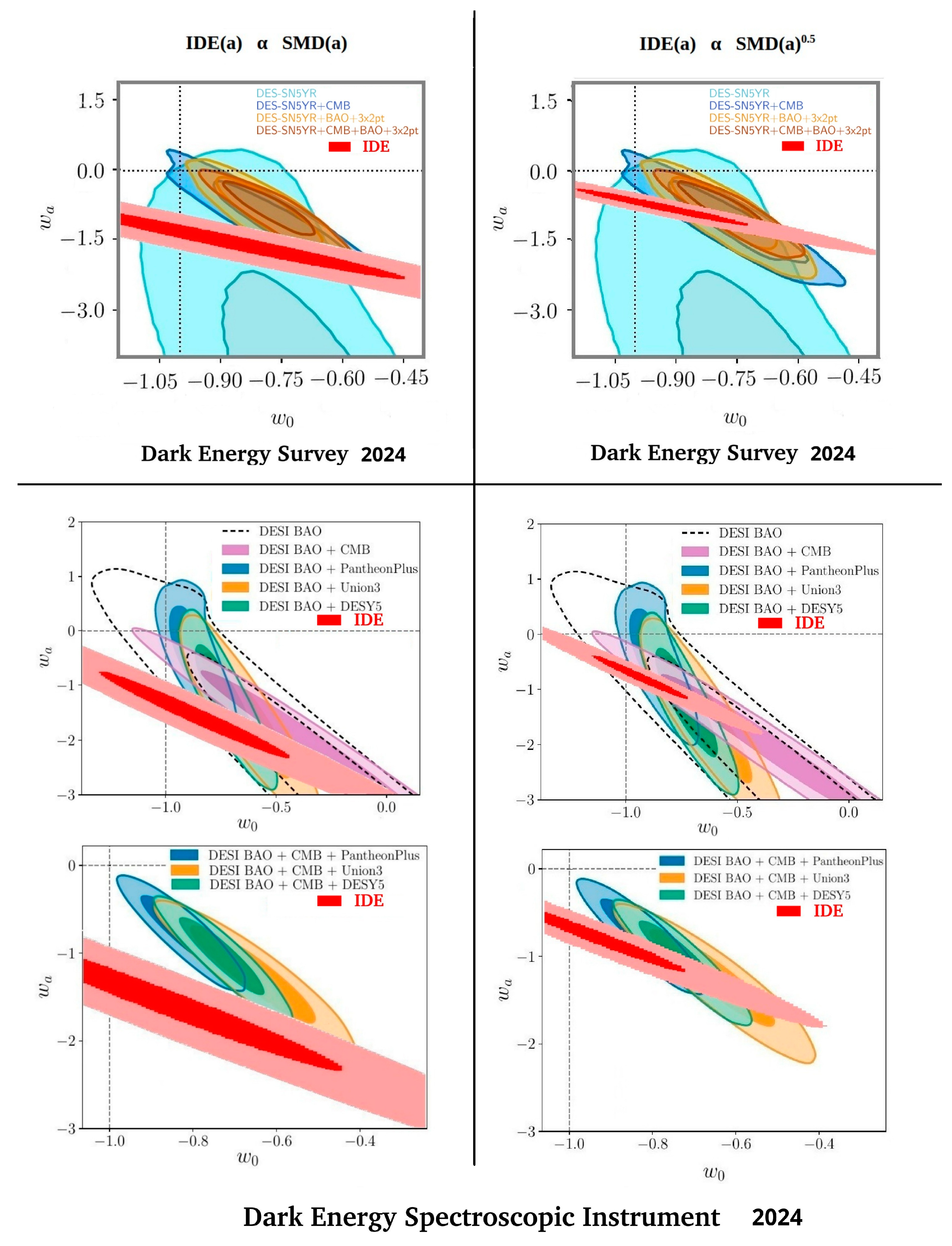
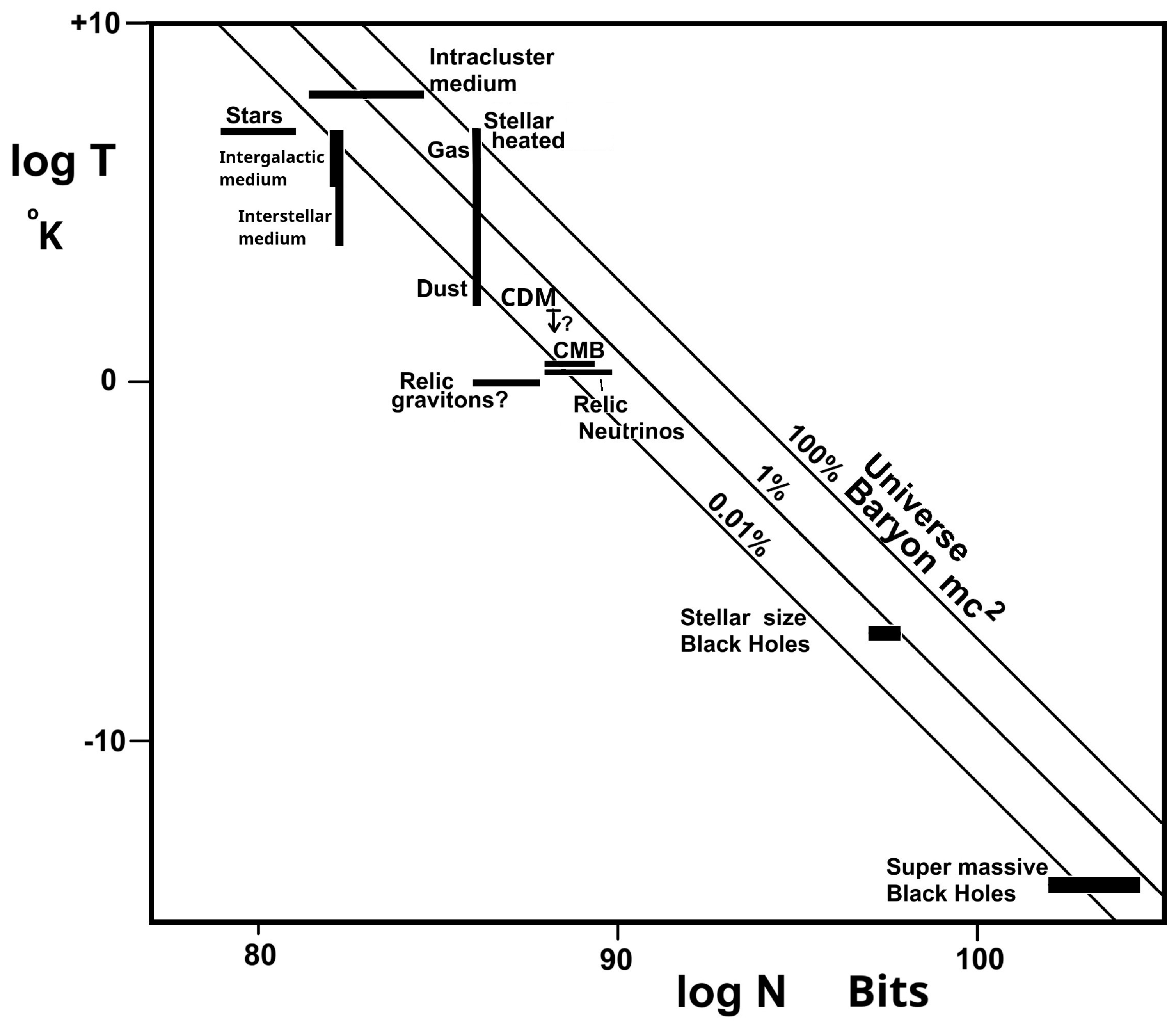

| Required Dark Side Property | IDE | ΛCDM | Scalar Fields/ Quintessence | MOND |
|---|---|---|---|---|
| Account for present dark energy density | YES, order of magnitude 1070 J | NO, not by very many orders of magnitude | Only by much fine tuning | ----- |
| Consistent with w0 − wa experiment data | YES, very good agreement | NO, on margins of likelihood region | Not specific −1 < w < +1 | ---- |
| Resolve Cosmological Constant problem | YES, Λ → 0 | NO | Only by much fine tuning | ---- |
| Resolve Cosmological Coincidence problem | YES, naturally | NO | Only by much fine tuning | ---- |
| Resolve H0 andσ8 Tensions | YES, possibly | NO | NO | ---- |
| Account for size of dark matter attributed effects | YES, same order of magnitude | NO, dark matter not even detected yet | ---- | YES, sometimes |
| Account for location of dark matter attributed effects | YES coincident with baryons | NO, not coincident with baryons | ---- | YES, Coincident with baryons |
| Account for early massive galaxies non-linear growth | YES, expect non-linear growth | NO, only linear, hierarchical growth | ---- | YES, expect non-linear growth |
Disclaimer/Publisher’s Note: The statements, opinions and data contained in all publications are solely those of the individual author(s) and contributor(s) and not of MDPI and/or the editor(s). MDPI and/or the editor(s) disclaim responsibility for any injury to people or property resulting from any ideas, methods, instructions or products referred to in the content. |
© 2025 by the author. Licensee MDPI, Basel, Switzerland. This article is an open access article distributed under the terms and conditions of the Creative Commons Attribution (CC BY) license (https://creativecommons.org/licenses/by/4.0/).
Share and Cite
Gough, M.P. Evidence for Dark Energy Driven by Star Formation: Information Dark Energy? Entropy 2025, 27, 110. https://doi.org/10.3390/e27020110
Gough MP. Evidence for Dark Energy Driven by Star Formation: Information Dark Energy? Entropy. 2025; 27(2):110. https://doi.org/10.3390/e27020110
Chicago/Turabian StyleGough, Michael Paul. 2025. "Evidence for Dark Energy Driven by Star Formation: Information Dark Energy?" Entropy 27, no. 2: 110. https://doi.org/10.3390/e27020110
APA StyleGough, M. P. (2025). Evidence for Dark Energy Driven by Star Formation: Information Dark Energy? Entropy, 27(2), 110. https://doi.org/10.3390/e27020110






